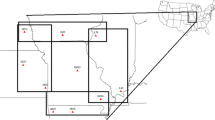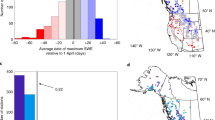Abstract
Wintertime precipitation sample data from 55 Snowpack sites and 17 National Atmospheric Deposition Program (NADP)/National Trends Network Wetfall sites in the Rocky Mountain region were examined to identify long-term trends in chemical concentration, deposition, and precipitation using Regional and Seasonal Kendall tests. The Natural Resources Conservation Service snow-telemetry (SNOTEL) network provided snow-water-equivalent data from 33 sites located near Snowpack- and NADP Wetfall-sampling sites for further comparisons. Concentration and deposition of ammonium, calcium, nitrate, and sulfate were tested for trends for the period 1993–2012. Precipitation trends were compared between the three monitoring networks for the winter seasons and downward trends were observed for both Snowpack and SNOTEL networks, but not for the NADP Wetfall network. The dry-deposition fraction of total atmospheric deposition, relative to wet deposition, was shown to be considerable in the region. Potential sources of regional airborne pollutant emissions were identified from the U.S. Environmental Protection Agency 2011 National Emissions Inventory, and from long-term emissions data for the period 1996–2013. Changes in the emissions of ammonia, nitrogen oxides, and sulfur dioxide were reflected in significant trends in snowpack and wetfall chemistry. In general, ammonia emissions in the western USA showed a gradual increase over the past decade, while ammonium concentrations and deposition in snowpacks and wetfall showed upward trends. Emissions of nitrogen oxides and sulfur dioxide declined while regional trends in snowpack and wetfall concentrations and deposition of nitrate and sulfate were downward.






Similar content being viewed by others
References
Anderson, N., Strader, R., & Davidson, C. (2003). Airborne reduced nitrogen: ammonia emissions from agriculture and other sources. Environment International, 29, 277–286.
Beem, K. B., Raja, S., Schwandner, F. M., Taylor, C., Lee, T., Sullivan, A. P., Carrico, C. M., McMeeking, G. R., Day, D., Levin, E., Hand, J., Kreidenweis, S. M., Schichtel, B., Malm, W. C., & Collett, J. L., Jr. (2010). Deposition of reactive nitrogen during the Rocky Mountain Airborne Nitrogen and Sulfur (RoMANS) study. Environmental Pollution, 158, 862–872.
Benedict, K. B., Day, D., Schwandner, F. M., Kreidenweis, S. M., Schichtel, B., Malm, W. C., & Collett, J. L., Jr. (2013). Observations of atmospheric reactive nitrogen species in Rocky Mountain National Park and across northern Colorado. Atmospheric Environment, 64, 66–76.
Bowker, G. E., Schwede, D. B., Lear, G. G., Warren-Hicks, W. J., & Finkelstein, P. L. (2011). Quality assurance decisions with air models: a case study of imputation of missing input data using EPA’s Multi-Layer Model. Water, Air, & Soil Pollution, 222, 391–402.
Burns, D. A. (2002). The effects of atmospheric nitrogen deposition in the Rocky Mountains of Colorado and southern Wyoming—a synthesis and critical assessment of published results: U.S. Geological Survey Water-Resources Investigations Report 02–4066, 36 p.
Burns, D. A. (2003). Atmospheric nitrogen deposition in the Rocky Mountains of Colorado and southern Wyoming—a review of new analysis of past study results. Atmospheric Environment, 37, 921–932.
Clarisse, L., Clerbaux, C., Dentener, F., Hurtmans, D., & Coheur, P. (2009). Global ammonia distribution derived from infrared satellite observations. Nature Geoscience, 2, 479–483.
Clow, D. W., Ingersoll, G. P., Mast, M. A., Turk, J. T., & Campbell, D. H. (2002). Comparison of snowpack and winter wet-deposition chemistry in the Rocky Mountains, USA. Implications for winter dry deposition. Atmospheric Environment, 36, 2337–2348.
Driscoll, C. T., Whitall, D., Aber, J., Boyer, E., Castro, M., Cronan, C., Goodale, C. L., Groffman, P., Hopkinson, C., Lambert, K., Lawrence, G., & Ollinger, S. (2003). Nitrogen pollution in the northeastern United States: sources, effects, and management options. BioScience, 53(4), 357–374.
Fenn, M. E., Haeuber, R., Tonnesen, G. S., Baron, J. S., Grossman-Clark, S., Hope, D., Jaffe, D. A., Copeland, S., Geiser, L., Rueth, H. M., & Sickman, J. O. (2003). Nitrogen emissions, deposition, and monitoring in the Western United States. BioScience, 53(4), 391–403.
Heald, C. L., Collett, J. L., Lee, T., Benedict, K. B., Schwandner, F. M., Li, Y., Clarisse, L., Hurtmans, D. R., Van Damme, M., Clerbaux, C., Coheur, P. F., Philip, S., Martin, R. V., & Pye, H. O. T. (2012). Atmospheric ammonia and particulate inorganic nitrogen over the United States. Atmospheric Chemistry and Physics, 12, 10295–10312.
Helsel, D.R., & Hirsch, R.M. (2002). Statistical Methods in Water Resources: US Geological Survey, 510 p. [Techniques of Water Resources Investigations of the United States Geological Survey, Book 4, Hydrologic Analysis and Interpretation, Chapter A3].
Helsel, D. R., & Frans, L. M. (2006). Regional Kendall test for trend. Environmental Science and Technology, 40, 4066–4073.
Helsel, D. R., Mueller, D. K., & Slack, J. R. (2006). Computer program for the Kendall family of trend tests. US Geological Survey Scientific Investigations Report 2005–5275, 4p. http://pubs.usgs.gov/sir/2005/5275/. Accessed 20 September 2015.
Ingersoll, G. P., Mast, M. A., Campbell, D. H., Clow, D. W., Nanus, L., & Turk, J. (2008). Trends in snowpack chemistry and comparison to National Atmospheric Deposition Program results for the Rocky Mountains, US, 1993–2004. Atmospheric Environment, 42, 6098–6113.
Ingersoll, G.P., Mast, M.A., Swank, J.M., & Campbell, C.D. (2011). Rocky Mountain snowpack physical and chemical data for selected sites. U.S. Geological Survey Data Series 570, 12 p. http://pubs.usgs.gov/ds/570/. Accessed 20 September 2015.
Knowles, N., Dettinger, M. D., & Cayan, D. R. (2006). Trends in snowfall versus rainfall in the Western United States. Journal of Climate, 19, 4545–4559.
Morris, K., Mast, M. A., Clow, D. C., Wetherbee, G., Baron, J., Taipale, C., et al. (2014). 2012 monitoring and tracking wet nitrogen deposition at Rocky Mountain National Park. Natural Resource Report NPS/NRSS/ARD/NRR—2014/757, 24p.
Myles, L. (2009). Underestimating ammonia. Nature Geoscience, 2, 461–462.
National Acid Precipitation Assessment Program (2011). National Acid Precipitation Assessment Program Report to Congress 2011: An Integrated Assessment. 132p. http://ny.water.usgs.gov/projects/NAPAP/NAPAP_2011_Report_508_Compliant.pdf . Accessed 20 September 2015.
National Atmospheric Deposition Program (2015). NADP Maps and Data. http://nadp.sws.uiuc.edu/data/. Accessed 20 September 2015.
National Atmospheric Deposition Program/National Trends Network (2015a). National Trends Network. http://nadp.sws.uiuc.edu/ntn/. Accessed 20 September 2015.
National Atmospheric Deposition Program/National Trends Network (2015b). Description of parameters included in NADP/NTN report of weekly concentration data. http://nadp.sws.uiuc.edu/documentation/notes-wk.html. Accessed 20 September 2015.
National Drought Mitigation Center (2015). United States Drought Monitor, Contiguous U.S. http://droughtmonitor.unl.edu/Home/RegionalDroughtMonitor.aspx. Accessed 20 September 2015.
National Oceanic and Atmospheric Administration (2015). National Climatic Data Center, Climate at a Glance. http://www.ncdc.noaa.gov/cag/. Accessed 20 September 2015.
National Park Service (2015a). Snowpack chemistry monitoring protocol for the Rocky Mountain Network; narrative and standard operating procedures. USGS Administrative Report. https://science.nature.nps.gov/im/units/romn/monitor/snow/docs/Ingersoll_etal2009_ROMNSnowChemistryProtocol_FINAL_Web.pdf. Accessed 20 September 2015.
National Park Service (2015b). Dry Deposition Monitoring Overview. http://www.nature.nps.gov/air/monitoring/. Accessed 20 September 2015.
National Water and Climate Center (2015a). Snow Telemetry (SNOTEL) and Snow Course Data and Products. http://www.wcc.nrcs.usda.gov/snow/. Accessed 20 September 2015.
National Water and Climate Center (2015b). Snow Surveys and Water Supply Forecasting. http://www.wcc.nrcs.usda.gov/factpub/sect_4b.html. Accessed 20 September 2015.
Nilles, M. A. (2000). Atmospheric Deposition Program of the U.S. Geological Survey. US Geological Fact Sheet 112–00, 6p. https://bqs.usgs.gov/acidrain/program.pdf. Accessed 20 September 2015.
Pinder, R. W., Gilliland, A. B., & Dennis, R. L. (2008) Environmental impact of atmospheric NH3 emissions under present and future conditions in the eastern United States. Geophysical Research Letters, 35(12), L12808.
Pye, H. O. T., Liao, H., Wu, S., Mickley, L. J., Jacob, D. J., Henze, D. K., & Seinfeld, J. H. (2009). Effect of changes in climate and emissions on future SO4-nitrate-ammonium aerosol levels in the United States. Journal of Geophysical Research, 114, 1–18.
Rocky Mountain Regional Snowpack Chemistry (2015). Data, combined data, 1993–2013. http://co.water.usgs.gov/projects/RM_snowpack/. Accessed 20 September 2015.
Saros, J. E., Clow, D. W., Blett, T., & Wolfe, A., P. (2010) Critical nitrogen deposition loads in high-elevation lakes of the western US inferred from paleolimnological records. Water Air Soil Pollution, 216(1), 193–202.
Stensland, G. L., Bowersox, V. C., Larson, B., & Claybrooke, R. D. (2001). Comparison of ammonium in USA wet deposition to ammonia emission estimates. Illinois State Water Survey, presented in the 10th International Emission Inventory Conference, May 1–3, 2001. http://www.epa.gov/ttnchie1/conference/ei10/. Accessed 20 September 2015.
TIBCO Spotfire S+ (2009). TIBCO Software Inc. http://spotfire.tibco.com/. Accessed 20 September 2015.
U. S. Census Bureau (2015). Population Distribution and Change: 2000 to 2010. http://www.census.gov/prod/cen2010/briefs/c2010br-01.pdf. Accessed 20 September 2015.
U.S. Environmental Protection Agency (2012). Our Nation’s Air, Status and Trends Through 2010. USEPA Report 454/R–12–001, February. U.S. Environmental Protection Agency, Office of Planning and Standards, Research Triangle Park, North Carolina.
U.S. Environmental Protection Agency (2015a). EPA Home >> Air and Radiation >> CAMD >> CASTNET >> Maps and Charts. http://epa.gov/castnet/. Accessed 20 September 2015.
U.S. Environmental Protection Agency (2015b). The 2011 National Emissions Inventory, Maps and Fusion Tables. http://www.epa.gov/ttn/chief/net/2011inventory.html. Accessed 20 September 2015.
U.S. Environmental Protection Agency (2015c). EPA Home >> Air and Radiation >> Six Common Pollutants >> Sulfur Dioxide. http://www.epa.gov/oaqps001/sulfurdioxide/. Accessed 20 September 2015.
Vet, R., Artz, R. S., Carou, S., Shaw, M., Ro, C., Aas, W., Baker, A., Bowersox, V. C., Dentener, F., Galy-Lacaux, C., Hou, A., Pienaar, J. J., Gillett, R., Forti, M. C., Gromov, S., Hara, H., Khodzher, T., Mahowald, N. M., Nickovic, S., Rao, P. S. P., & Reid, N. W. (2014). A global assessment of precipitation chemistry and deposition of sulfur, nitrogen, sea salt, base cations, organic acids, acidity and pH, and phosphorus. Atmospheric Environment, 93, 3–100.
Acknowledgments
The authors greatly appreciate the funding support from the National Park Service, the USDA Forest Service, the Colorado Department of Public Health and Environment, the Teton Conservation District, and the U.S. Geological Survey. We also acknowledge the assistance of many individuals who contributed to this effort. In particular, we thank Ann Acheson, Nic Bencke, Gina Biere, Tamara Blett, Stan Bones, Mike Britten, Don Campbell, Michael Curtis, Liese Dean, Jay Dorr, Sam Duerksen, Thomas Dzomba, Dan Ely, Dan Fagre, Ben Glass, Bob Hammer, Mary Hektner, Nan Ingersoll, Joe Marcos, Craig McClure, Lisa McKeon, Greg Miller, David Mueller, Douglas Myhre, Rick Neam, Mark Nilles, Gary Nelson, Gordon Pierce, Ted Porwoll, Don Rosenberry, Orville Rosenberry, John Sacklin, Kevin Sage, Robb Sgroi, Craig Skeie, Jeff Sorkin, Ed Snook, Mark Story, Terry Svalberg, Kathy Tonnessen, John Turk, and Eric Winthers. Special thanks also is due to the generous logistical support from the following ski areas: The Big Mountain, Big Sky, Loveland, Showdown, Snowbowl, Taos Ski Valley, and Teton Village. Two anonymous reviewers provided useful comments. Dennis Cleary developed the emissions plots. Bob Larson compiled the NADP NTN data.
Author information
Authors and Affiliations
Corresponding author
Rights and permissions
About this article
Cite this article
Ingersoll, G.P., Miller, D.C., Morris, K.H. et al. Changing Regional Emissions of Airborne Pollutants Reflected in the Chemistry of Snowpacks and Wetfall in the Rocky Mountain Region, USA, 1993–2012. Water Air Soil Pollut 227, 94 (2016). https://doi.org/10.1007/s11270-016-2784-4
Received:
Accepted:
Published:
DOI: https://doi.org/10.1007/s11270-016-2784-4




